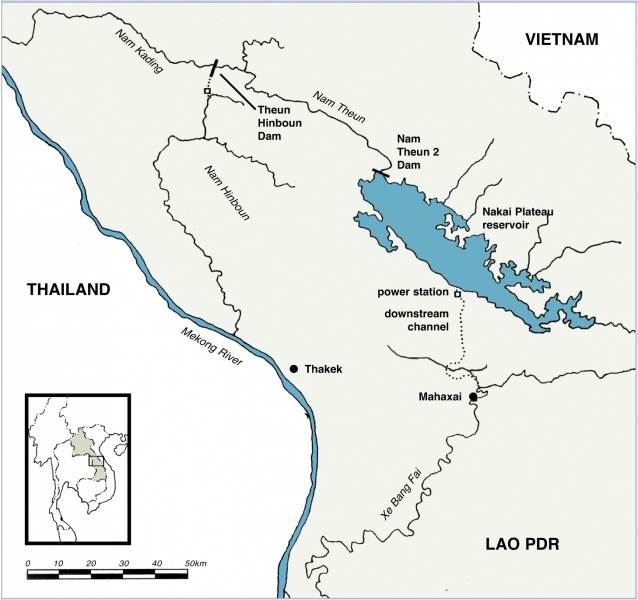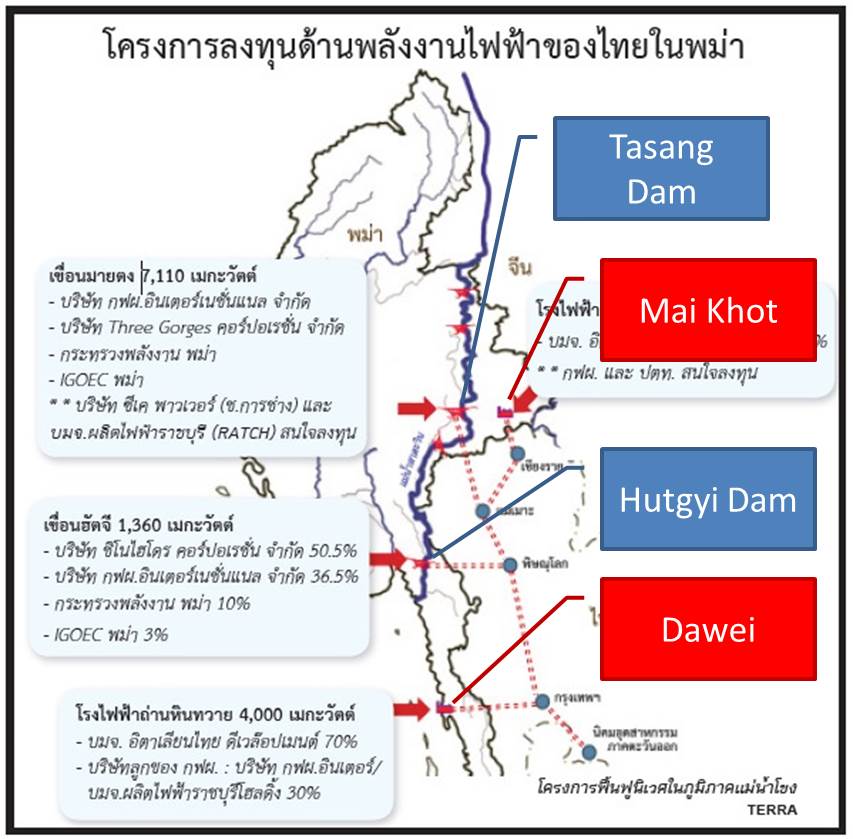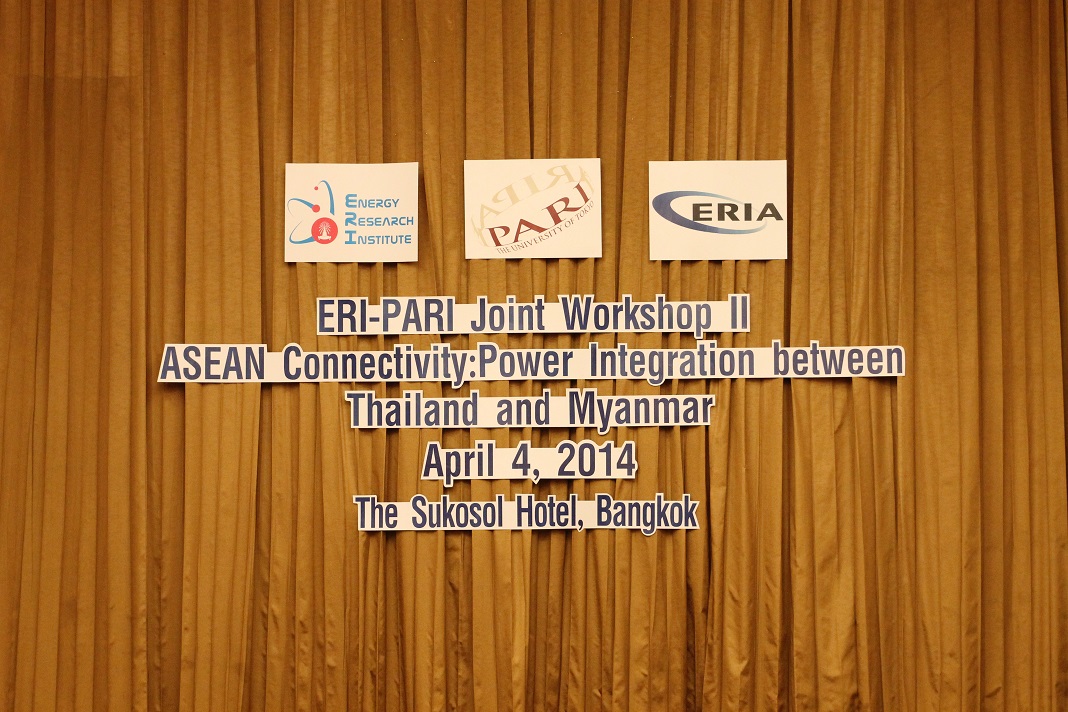The 2nd PARI-ERI Joint Workshop Detailed Report
The 2nd PARI-ERI Joint Workshop Flash Report
日本語ページへ
May. 14, 2014

photo by Prof. Ukrist Pathamanand
ASEAN Connectivity: Power Integration between Thailand and Myanmar
| [Date] | Friday, April 4, 2014, 10:00-17:00 |
|---|---|
| [Venue] | The Sukosol Bangkok, Thailand |
| [Co-hosted by] | Energy Research Institute (ERI), Chulalongkorn University Policy Alternatives Research Institute (PARI), the University of Tokyo |
| [Supported by] | Economic Research Institute for ASEAN and East Asia (ERIA) |
Welcome Remarks
Prof. Tharapon Vitidsant, Director, ERI
Opening Speech
Prof. Ichiro Sakata, Director, PARI / Professor, Graduate School of Engineering, the University of Tokyo Handout
Scope of the Workshop
Mr. Kensuke Yamaguchi, Visiting Researcher, ERIA Handout
Keynote Speech
Dr. Venkatachalam Anbumozhi, Energy Economist, ERIA Handout
Presentations
Mr. Danuja Simasathien, Executive Vice President, Electricity Generating Public Company (EGCO) Handout
Mr. Masayuki Seino, Project Researcher, PARI, the University of Tokyo Handout
Panel Discussion 1
Moderator
Prof. Hisashi Yoshikawa, Project Professor, PARI / Graduate School of Public Policy (GraSPP), the University of Tokyo
Welcome Remarks
Mr. Shimpei Yamamoto, Managing Director for Research Affairs, ERIA
Keynote Speech
Mr.Setsuo Iuchi, President, JETRO Bangkok Handout
Presentations
Dr. Suthee Traivivatane, Researcher, ERI Handout
Mr. Keith Rabin, President, KWR International Inc. Handout
Q&A
Presentation
Prof. Ukrist Pathamanand, Professor, Institute of Asian Studies, Chulalongkorn University Handout
Mr. Tomoyuki Kawabata, Senior Representative, Japan International Cooperation Agency (JICA), Thailand Handout
Panel Discussion 2
Moderator / Wrap up
Prof. Hisashi Yoshikawa, Project Professor, PARI / Graduate School of Public Policy (GraSPP), the University of Tokyo
Closing Remarks
Prof. Surichai Wun'gaeo, Honorary Professor / Director, Center for Peace and Conflict Studies, Chulalongkorn University
Connectivity in the electricity field
With the founding of the ASEAN Economic Community (AEC) in 2015, there are many opportunities to hear the keyword “connectivity” in ASEAN countries. The word “connectivity” is used in human, physical, institutional, and various other scenes, and the increase in human, materialistic, and economic mobility will have considerable benefits for the countries of the region. For example, reduction in logistics cost from upgrading the East-West Economic Corridors across the Mekong River will create a comparative advantage for the ASEAN region in the international division of labor.
However, it is clear that connectivity is not as simple in some fields. A prime example is the field of electricity. The merit of more people having access to inexpensive electricity through the cross-border grid is well recognized among the countries in the region, and in fact, some bilateral electricity trade has already been realized. For example, Laos, which has an abundance of hydroelectric energy, is increasingly exporting electricity to Thailand, where electricity demand has been increasing rapidly. However, electricity trade between Thailand and Myanmar, which borders Thailand, has not advanced.
Why does this difference occur? What are the barriers (obstacles) for electricity trade? What measures are necessary to remove these barriers?
A collaborative study between Policy Alternatives Research Institute (PARI), the University of Tokyo, and the Energy Research Institute (ERI), Chulalongkorn University, Thailand was started last autumn, and the target of the project is to determine how to take advantage of the economic dynamism of Thailand to improve people’s access to electricity in rural areas of Myanmar. This fiscal year, we plan to host stakeholder meetings to discuss the above-mentioned issues in consideration of the local perspective of Thailand.
As an interim meeting, we held the 2nd PARI-ERI joint workshop, “ASEAN Connectivity: Power Integration between Thailand and Myanmar,” with the support of the Economic Research Institute for ASEAN and East Asia (ERIA) in Bangkok on April 4, 2014. This was the second such meeting following the first workshop that was held last December, and the final workshop will be held in June. More than 30 people from a variety of sectors across industry, government, and academia attended the workshop from Japan and Thailand and the participants actively exchanged opinions.
A “win-win” electricity trade relationship between Thailand and Laos (Overview of the Morning Session)
After the welcome remarks by Prof. Tharapon (Director, ERI), Prof. Ichiro Sakata (Director, PARI) shared the background significance of the ERIA project and confirmed the awareness of the problems. Mr. Yamaguchi (Visiting Researcher, ERI) explained that the final goal of the PARI-ERI collaborative investigation this year is to clarify three questions and make recommendations to stakeholders. The three questions include: (1) the ideal form of a “win-win” electricity trade relationship between Thailand and Myanmar, (2) barriers in constructing the “win-win” electricity trade relationship between Thailand and Myanmar, and (3) the role of the people involved in removing those barriers. In preparation for the proposal to be brought to the final workshop in June, in this workshop, we focused on the second question, barriers in constructing a “win-win” relationship.
In the keynote speech by Dr. Anbumozhi (Researcher, ERIA), electricity trade between Laos and Thailand over the Nam Theun 2 dam (NT2), one of the most advanced projects in this region, was explained, along with the long-term prospect of energy supply and demand in Southeast Asia. NT2 is a large-scale 1,070 MW hydroelectric power plant and 95% of the power generated is exported to Thailand. Electricity trade is a quick way for Laos to acquire foreign currency and an inexpensive way for Thailand to expand and reinforce its facilities to cope with the increasing domestic demand for power. This project is a benchmark of “win-win” projects recently undertaken in ASEAN countries.

Next, Mr. Danuja of the Electricity Generating Co., Ltd. (EGCO; an investor holding 25% of NT2) explained the Dawei Power Project in which the company is now engaged. The main purpose of this project is to supply the Dawei Special Economic Zone with electricity; however, because future electricity demand in this zone is still uncertain, it intends, at least for the moment, to finance the project by exporting electricity to Thailand. The Myanmar government is being asked to commit to the project by establishing the relevant legislation.
Based on the example of NT2, Mr. Seino (Researcher, PARI) suggested the following three points for electricity generating projects invested from Thailand in Myanmar. First, a part of the electricity generated in Myanmar should be supplied to Thailand. Second, the remaining available electricity should be supplied to the domestic market in Myanmar through Myanmar Electric Power Enterprise (MEPE). Third, each project should contribute to steadily improving the quality of life for the local people. Accordingly, the initial premise of a “win-win” project is that the parties involved are aware of their benefits and are united by a shared vision.
Barriers for electricity connectivity between Thailand and Myanmar (Overview of the Afternoon Session)
What are the barriers to building this kind of “win-win” relationship? To gain a better insight on the subject, the afternoon session was held including a participatory process. After the opening speech by Mr. Yamamoto, the Managing Director for Research Affairs at ERIA, which supports the PARI-ERI collaborative investigation, Mr. Iuchi (President, JETRO Bangkok) presented a view on investments in Myanmar. Myanmar is considered a promising frontier in the “Thailand + 1” movement that targets production in other countries instead of limiting operations to Thailand, which is the current production base of ASEAN. This is because of the downward trend in the labor force in Thailand from the aging population and surging labor costs. On the other hand, power supply may become the bottleneck, and the reinforcement of electric power facilities is an urgent issue not only for Myanmar but also for countries such as Thailand and Japan, which are planning on making inroads into the region.
Responding to the issues raised, Dr. Suthee (Researcher, ERI) summarized electric power developments in Myanmar through Thai investments and explained the barriers involved, which was the focus of the participatory workshop. The three big projects with scales of 1,000 MW or larger set up in Myanmar with investments from Thailand, Dawei, Tasang, and Hatghi, each face different barriers. Dr. Suthee presented primary data relating to the barriers of the projects obtained through document surveys and interviews and presented, as a hypothesis, results that were organized from the perspectives of the economy, technology, governments, systems, society, and environment based on the previous studies.

First, for coal-fired power generation, including the Dawei project, economic efficiency is an important factor because the fuel cost is always imposed on the project. It is difficult to find lenders under present conditions for which the long-term purchase price is low for the electricity supplied by the Electricity Generating Authority of Thailand. Second, in hydroelectric power generation, a large-scale business will assure economic efficiency. With an expected output of over 7,000 MW, Tasang could be called an “ultra” large power plant compared with the total generation capacity of Myanmar (3,595 MW as of 2012). Naturally, a significant adverse impactis expected on the local society and environment. In particular, the removal of such a social and environmental barriers is very difficult in a country where a social chasm about state-building exists in the background.
Meanwhile, before starting the participatory meeting, Mr. Rabin (KWR International, Inc.), Prof. Ukrist (Chulalongkorn University), and Mr. Kawabata (Deputy Executive Manager, JICA Thailand Office) provided additional information to facilitate a better understanding of the barriers. The first two reported on field surveys on social barriers in Myanmar. The local view is that the maintenance of facilities is a big issue, and therefore human resource development is needed. Professor Ukrist pointed out that the voice of the people carries more weight following the democratization of Myanmar and that the project should consider this. Mr. Kawabata’s report suggested a concrete solution for overcoming economic barriers. In recent years, in addition to a yen loan scheme, JICA has newly established the Private Sector Investment Finance (PSIF) scheme and other initiatives to support private sector projects. While it is difficult to acquire private lenders in Myanmar, the use of, for example, JICA’s public scheme will be an option to remove the economic barriers.
Fostering of a civil society and removal of barriers
Based on the related information, participants were divided into two discussion groups, one on coal-fired power generation and the other on large-scale hydroelectric power generation, to discuss the second question, barriers in constructing “win-win” relationships. First, for hydroelectric power generation, the distance to the nearest transformer station was pointed out as a technical issue and from an economical perspective, it was identified that only large-scale dams are a successful business model. These two factors suggest that land sites suited for hydroelectric power generation are very limited and that fierce competition could emerge between interested investors.
Dawei (an on-going project) dominated the discussion on coal-fired power generation. First, the commitment of the Myanmar government was identified to be insufficient. With regard to environmental and social aspects, companies can respond accordingly and perform business activities only if the related legal system is well constructed. The commitment of the Myanmar government is required for the establishment of the relevant legistlation. Second, it was pointed out that the demands of Myanmar, such as a free stock shares (free stock acquisition) and free power (free electricity distribution), were too different from standard global business practices. Third, the method for calculating the long-term electricity purchase price was discussed.
We sufficiently clarified the barriers, which was the purpose of this workshop. However, based on past experience, it is obvious that removing barriers will not be an easy task. Thus far, the effort of removing barriers has often been directed to the government, and it is true that this is important to remove barriers. However, is it effective enough to approach only the government? Fostering civil relationships with society may also help. In the closing remarks, Honorary Prof. Surichai (Chulalongkorn University) emphasized that, increasingly today, citizens are becoming important stakeholders and citizen’s voice must be incorporated in the policymaking process of the government. He also stated that the importance of international collaboration is growing owing to differences in capabilities between governments. It seems difficult to remove barriers without considering the maturity of the civil society of Myanmar, and clearly, there are areas the government cannot control. Thus, collaboration between various interested parties, including citizens, must be pursued. After further analysis and investigation for guiding principles, we will approach the third question, the role of the people involved in removing barriers, in the last workshop in June.

Related Links
The 2nd PARI-ERI Joint Workshop Flash Report - ASEAN Connectivity: Power Integration between Thailand and Myanmar
The 1st PARI-ERI Joint Workshop Report - The Evolving Energy Relationship between Thailand and Myanmar - A View From Thailand -
ASEAN Connectivity: Power Integration between Thailand and Myanmar (Energy Research Institute, Chulalongkorn University)
The Evolving Energy Relationship between Thailand and Myanmar: A View From Thailand (Energy Research Institute, Chulalongkorn University)
Technology Assessment Research Demonstration Project/ERIA Energy Research in East Asia


